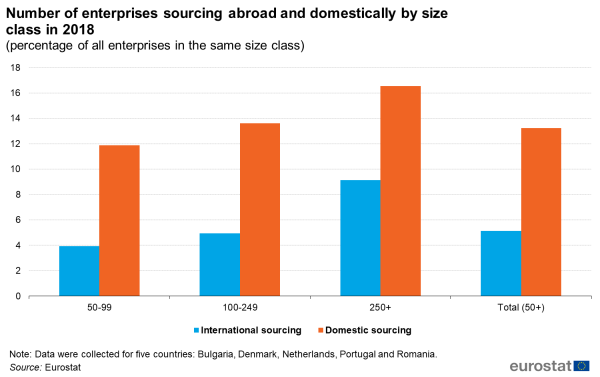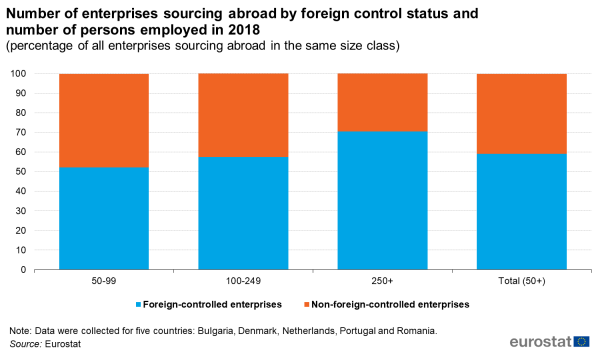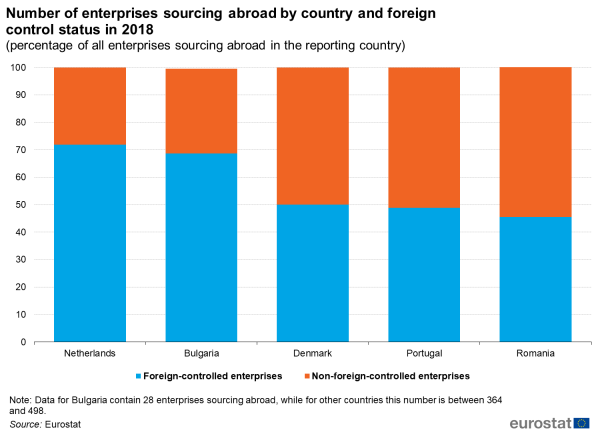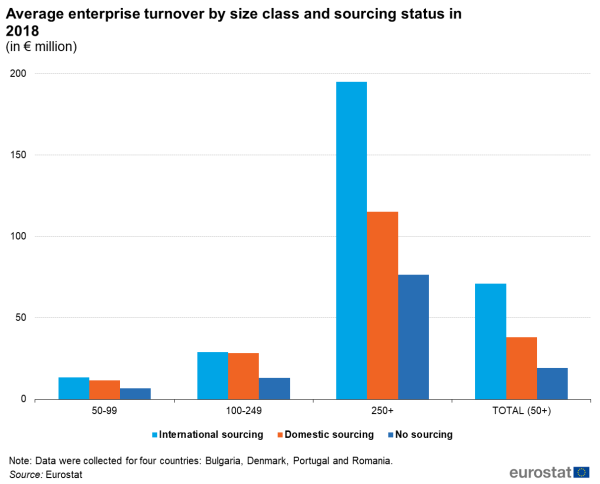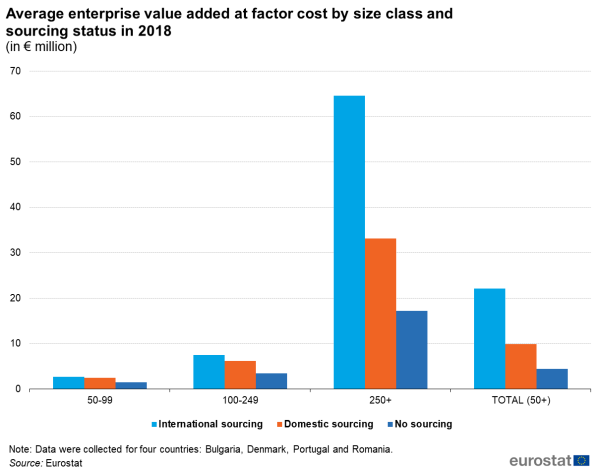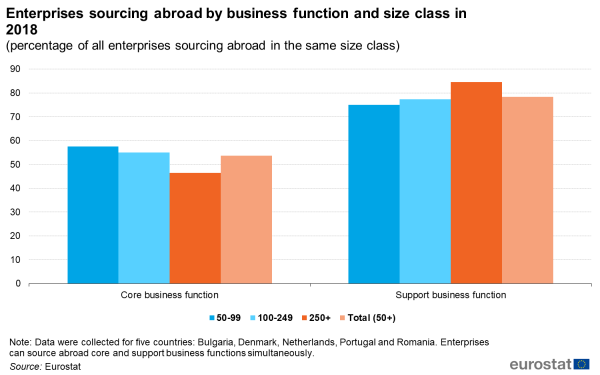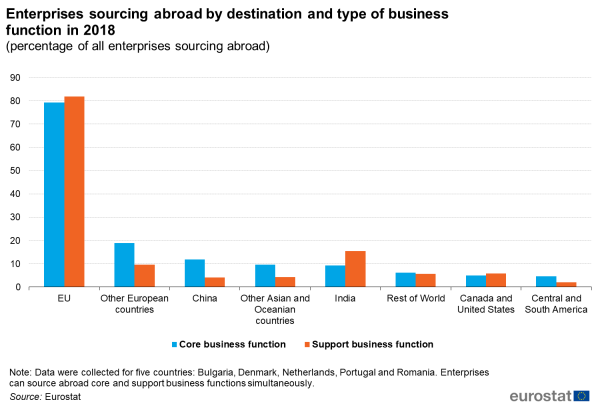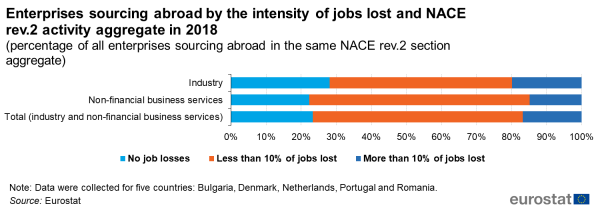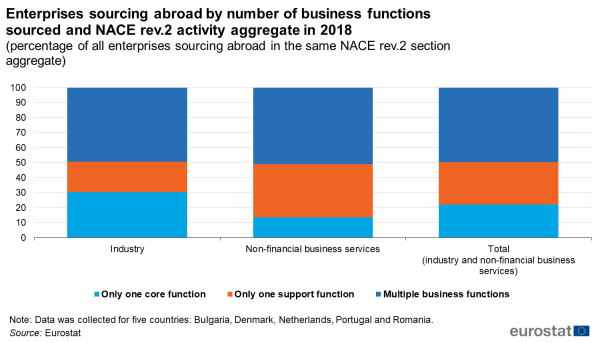Linking statistics on international sourcing with other business statistics
Data extracted in November 2022.
No planned article update.
Authors: Nikola Sunjka (Eurostat, Economic globalisation, International sourcing and global value chains), Georgios Papadopoulos (Eurostat, International trade in services)
Highlights
Enterprises that most commonly source abroad are large, foreign-controlled and engage in imports and exports simultaneously.
When enterprises source abroad, they exhibit much higher average values of turnover and value added at factor cost than enterprises that do not source abroad across all size classes of enterprises.
Compilers of European business statistics often face a dilemma: on the one hand, user and policy requirements demand additional information on the structure and development of European enterprises. On the other hand, budget constraints and the reluctance to increase the burden on survey respondents and national statistical institutes put tight restraints on any increase in data requirements. One solution for this dilemma is to combine existing statistical information by linking together data at the microdata level without increasing the burden on enterprises. Microdata linking makes it possible to discover new information and develop new statistics and indicators by combining existing data sets with new data collections.
This article describes the microdata linking project launched in 2019, which sought to link the results of the international sourcing survey to structural business statistics (SBS), international trade in goods statistics (ITGS) and foreign affiliates statistics (FATS) at enterprise level, using unique enterprise identification numbers. This microdata linking project was set up by Eurostat in 2018 and carried out in 2019 by the national statistical offices in five EU Member States (Bulgaria, Denmark, the Netherlands, Portugal and Romania). Two similar projects were conducted in 2010 and 2013 using the same business statistics. This new microdata linking exercise uses the data from the international sourcing surveys carried out in 2017 and 2018.
Full article
Main findings
The following sections present the main findings of this project before outlining the data sources and definitions used in the project.
- Two-way traders, foreign-controlled enterprises, and enterprises with more than 250 persons employed are the three types of enterprises that most commonly source abroad.
- Enterprises that only export rarely source abroad.
- When enterprises source abroad, they exhibit much higher average values of turnover and value added at factor cost than enterprises that do not source abroad across all size classes of enterprises.
- Support business functions are often sourced abroad, regardless of enterprise size.
- Enterprises most commonly source within the EU, regardless of the business function type.
- International sourcing most commonly results in job losses of less than 10 %.
- Enterprises are more likely to source to only one geographical destination than to source to many geographical destinations
- Roughly half of sourcing enterprises source multiple business functions abroad simultaneously.
International sourcing, enterprise size, foreign control status and trader type
Enterprises with more than 250 persons employed most commonly source abroad
Data from the international sourcing survey was linked with SBS statistics to analyse the prevalence of sourcing abroad in enterprises by size class. All enterprises were classified into three groups by the number of persons employed (those employing 50-99 persons, those employing 100-249 persons, and those employing 250 persons or more). Figure 1 shows that international and domestic sourcing are most common for enterprises employing 250 persons or more (9.12 % of which source internationally and 16.55% of which source domestically) and the least common for enterprises employing 50-99 persons (3.94% of which source internationally and 11.88 % of which source domestically). In general, international sourcing for all enterprises is a relatively uncommon phenomenon, with only 5.11 % of enterprises employing more than 50 persons engaged in international sourcing in 2018. However, the share of enterprises sourcing abroad in the smaller size classes of enterprise is not negligible.
Figure 2 shows that the prevalence of international sourcing differs between countries, with it being most common in Denmark (11.6 % of all enterprises) and least common in Bulgaria (0.6 % of all enterprises). For all countries except Romania, the prevalence of international sourcing increases as the number of persons employed by the enterprise increases. For Romania, there are slightly fewer enterprises sourcing abroad that employ 100-249 persons (3.3 % of all enterprises within the size class) than enterprises that employ 50-99 persons (3.6 %).
Foreign-controlled enterprises are more likely to engage in international sourcing
Data from the international sourcing survey was linked with the inward foreign affiliates statistics to analyse the potential relationship between an enterprise being domestically controlled or foreign-controlled and the likelihood of it engaging in international sourcing (see Figure 3). Around 70 % of foreign-controlled enterprises with more than 250 persons employed engaged in international sourcing, while just over half of foreign-controlled enterprises with between 50 and 99 persons employed engaged in international sourcing. In total, 59 % of foreign-controlled enterprises with more than 50 persons employed engaged in international sourcing as opposed to 41 % of non-foreign-controlled enterprises with more than 50 persons employed.
Looking at the individual shares of the five reporting countries (Figure 4), higher percentages of foreign-controlled enterprises sourcing abroad are reported in the Netherlands (71.9 % of all enterprises source abroad) and Bulgaria (68.7 % of all enterprises source abroad). In contrast, much lower shares are reported in Portugal (48.8 %) and Romania (45.5 %).
Two-way traders are most likely to source abroad, while enterprises that only export rarely source abroad
Analysis of the ITGS and international sourcing statistics (Figure 5) showed links between the type of trader and the prevalence of international sourcing. By looking at how enterprises engage in international trade, enterprises can be classified as:
- non-traders (those that do not engage in international trade);
- occasional traders (their exports and imports are less than €5 000 and 5 % of turnover);
- importers only (they have imports greater than €5 000 and imports account for at least 5 % of turnover);
- exporters only (they have exports greater than €5 000 and imports account for at least 5 % of turnover);
- two-way traders (enterprises that are both importers and exporters).
Because two-way traders engage in the most intensive international trade, it is not surprising that they also represent the type of enterprise that engages most in international sourcing (48 % of all two-way trading enterprises source abroad). However, what is surprising is that the second most common type of enterprise engaging in international sourcing is occasional-trader enterprises (23 % of occasional-trader enterprises source abroad), while only 4 % of enterprises that only export engage in international sourcing. Finally, international sourcing is the most common for the largest two-way traders (17.1 % of two-way traders with 250 or more persons employed engage in international sourcing), while it is the least common for the exporter-only enterprises with 250 or more persons employed (only 0.7 % of which source abroad).
Turnover and value added at factor cost of enterprises sourcing abroad
Turnover and value added at factor cost of enterprises sourcing abroad are much higher than those of enterprises that do not source abroad
As shown in Figure 6, the average turnover of enterprises sourcing abroad (€70.9 million) is much higher than the average turnover of enterprises sourcing domestically (€38.1 million) or for enterprises that do not source at all (€19.2 million). Additionally, enterprises engaged in international sourcing can expect greater turnover than non-sourcing enterprises regardless of the enterprise size, with the largest difference found in enterprises with more than 250 persons employed (€194.9 million for enterprises with more than 250 persons employed sourcing abroad vs €76.6 million average turnover for enterprises with more than 250 persons employed that do not engage in any sourcing whether domestic or international).
Similar conclusions can be drawn by analysing the average value added at factor cost (Figure 7). In this case, the values for enterprises sourcing abroad (€22.1 million) are also much higher than the average values for enterprises sourcing domestically (€9.9 million) or for non-sourcing enterprises (€4.4 million). As is the case with average turnover, enterprises engaged in international sourcing can expect higher value added at factor cost than non-sourcing enterprises regardless of the enterprise size, with the largest difference again found in enterprises with 250 or more employees. Enterprises with 250 or more persons employed sourcing internationally had an average value added at factor cost of €64.6 million compared to an average value added at factor cost of €17.1 million for enterprises with 250 or more persons employed that do not source at all.
Business functions and sourcing destinations
Support business functions are most often sourced abroad, regardless of enterprise size
Figure 8 shows that enterprises are more likely to source their support business functions abroad (78.3 %) than their core business functions (53.6 %). This is true for all enterprises, regardless of their size. Additionally, over half of the international sourcing enterprises source their core business functions abroad, except for enterprises with more than 250 persons employed (only 46.5 % of which source their core business functions abroad).
Enterprises that source abroad were most likely to source within the EU, regardless of the business function type being sourced abroad
Figure 9 shows that, in 2018, enterprises that sourced abroad were most likely to source core business functions within the EU (79.3 %), followed by other, non-EU European countries (18.9 %) and China (11.8 %). Additionally, support business functions are most likely to be sourced within the EU (81.8 %), India (15.4%) and other, non-EU European countries (9.6 %). On the other hand, the least common destination of sourcing for both core business functions (4.6 %) and support business functions (2.0 %) is Central and South America.
Intensity measures of international sourincg
International sourcing is most likely to result in job losses of less than 10 %
Figure 10 shows that 59.9 % of enterprises that source abroad reported that the international sourcing activity was responsible for job losses of less than 10%, while 23.3 % reported that this international sourcing activity was not responsible for the loss of any jobs. And only 16.7 % of enterprises that source abroad reported that this international sourcing activity was responsible for job losses of more than 10%. Additionally, enterprises operating in non-financial business services were more likely to report job losses than enterprises operating in the industrial sector.
Enterprises are more likely to source to only one geographical destination than to source to many geographical destinations
Enterprises sourcing abroad can source to eight destinations, namely: the EU; other non-EU European countries; China, India, other Asian and Oceanian countries; Canada and the United States; Central and South America; and the rest of the world. Figure 11 shows that only around one third of enterprises source abroad from more than one destination (35%), with a relatively small difference between enterprises operating in the industry sector (37%) and those operating in the non-financial business services sector (34%).
Almost half of enterprises source multiple business functions abroad
Interestingly, roughly half of enterprises that source abroad source multiple business functions abroad. Of the other half, some source only one core business function abroad, and some source only one support business function abroad. However, comparing industry and non-financial business services sectors (Figure 12), it is more common in the industrial sector to source only one core business function abroad than to source only one support business function abroad (30.4 % of industrial enterprises source one core business function abroad, while 20.2 % of industrial enterprises source one support business function abroad). In non-financial business services, it is more common to source only one support business function than it is to source only one core function (35.5 % of non-financial business services enterprises source one support business function abroad, while 13.5 % of non-financial business services enterprises source one core function abroad).
Source data for tables and graphs
Data sources
Background
In 2017 and 2018, 16 European countries participated in the third international sourcing survey, which covered a reference period of the 3 previous years, and the enterprise population active in NACE Rev.2 sections B to N, without K, with more than 50 persons employed. The survey has since been renamed the global value chains survey (GVC survey) and has been included as official statistics in Regulation (EU) 2019/2152 on European Business Statistics ('the EBS Regulation').
In this microdata linking exercise, the reference year for all the data and figures is 2018. The population includes enterprises with more than 50 persons employed and with primary activities in NACE sections B to N, without K. This project mainly provides information on: (i) enterprises engaged in international sourcing (the movement of business functions currently performed in-house or domestically sourced by the resident enterprise to enterprises located abroad); (ii) business functions (a grouping of common tasks that enterprises must carry out regularly, either internally or externally, to bring goods or services to market); (iii) foreign control of enterprises; and (iv) the different intensity of sourcing effects on jobs, business functions and sourcing destinations.
The information presented in this article only relates to the reference year 2018, the population of enterprises with primary activities in NACE Rev.2 (Statistical classification of economic activities in the European Community) sections B to N, without K. Broadly speaking, the population covers the business economy without financial services. All the sampled enterprises have more than 50 persons employed.
Key definitions
Sourcing activities
Sourcing: The total or partial movement of business functions (core or support business functions) currently performed in-house of a resident enterprise to either non-affiliated (external suppliers) or affiliated enterprises located either domestically or abroad.
International sourcing: The total or partial movement of business functions (core or support business functions) currently performed in-house or domestically sourced by the resident enterprise to either non-affiliated (external suppliers) or affiliated enterprises located abroad.
Sourcing does not include: Expansion domestically or abroad; for example, a set-up of a new production line domestically or abroad without a movement of business functions domestically or abroad (core or support business functions) nor reduction of activity and jobs in the concerned enterprise.
Business functions
Core business function: Production of final goods or services intended for the market or third parties carried out by the enterprise and yielding income. Core business function equals, in most cases, the primary activity of the enterprise. It may also include other (secondary) activities if the enterprise considers them part of its core functions.
Support business function: Support business functions (ancillary activities) are carried out to permit or facilitate the production of goods or services intended for the market/for third parties by the enterprise. The support business functions' outputs are not intended directly for the market or third parties.
Jobs lost due to international sourcing
The enterprises are asked to estimate the total number (gross) of domestic jobs lost in the responding enterprises due to international sourcing. Domestic job losses in the responding enterprises that have taken place due to reasons other than international sourcing (e.g. domestic lay-offs, poor business cycle, etc.) are not included here. An enterprise may, e.g. record "jobs lost" due to international sourcing and still record an increase in its "number of employees and self-employed persons".
Context
The microdata linking approach
New statistics on enterprises have traditionally been produced by carrying out surveys. Microdata linking presents an innovative approach to obtaining new information on the economic performance of enterprises by linking different, existing statistical sources at the individual enterprise level (microdata level). This approach does not require new surveys to be carried out and thus does not increase the burden placed on enterprises.
The main benefits of the microdata linking approach are:
- microdata linking has significant potential to gather new statistical evidence without increasing the burden placed on respondents;
- a coordinated approach to microdata linking is a cost-effective way for national statistical offices to undertake microdata linking and ensures harmonised, comparable results across countries;
- microdata linking gives new insights into the behaviour of enterprises and the impact of this behaviour on various aspects of European economies;
- by linking various data sources, microdata linking makes it possible to conduct a regression analysis and, by extension, other types of statistical analysis, such as multivariate and cluster analysis.
Direct access to
See also
Methodology
- International-sourcing statistics - all activities (ESMS metadata file — iss_esms)
- Structural business statistics (ESMS metadata file — sbs_esms)
Legislation
- European Business Statistics Regulation (Regulation (EU) 2019/2152)
- Global Value Chains Implementing Regulation (Regulation (EU) 2022/918)
